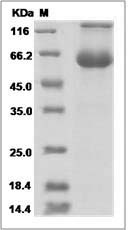-
Product Name
Canine PD1/PDCD1/CD279 (Fc Tag) recombinant protein
- Documents
-
Description
Programmed cell death 1, also known as PDCD1, is a type I transmembrane glycoprotein, and is an immunoreceptor belonging to the CD28/CTLA-4 family negatively regulates antigen receptor signaling by recruiting protein tyrosine phosphatase, SHP-2 upon interacting with either of two ligands, PD-L1 or PD-L2. PD1 inhibits the T-cell proliferation and production of related cytokines including IL-1, IL-4, IL-10 and IFN-γ by suppressing the activation and transduction of PI3K/AKT pathway. In addition, coligation of PD1 inhibits BCR-mediating signal by dephosphorylating key signal transducer. PD1 has been suggested to be involved in lymphocyte clonal selection and peripheral tolerance, and thus contributes to the prevention of autoimmune diseases. Furthermore, PD1 is shown to be a regulator of virus-specific CD8+ T cell survival in HIV infection. As a cell surface molecule, PDCD1 regulates the adaptive immune response. Engagement of PD-1 by its ligands PD-L1 or PD-L2 transduces a signal that inhibits T-cell proliferation, cytokine production, and cytolytic function.
-
Protein short names
PD-1; PDCD1; LY101; SLEB2; PDC1; HPD-L; PD1; HPD-1; CD279
-
Source/Expression Host
Human Cells
-
Expression Plasmid/cDNA
A DNA sequence encoding the canine PDCD1 (XP_543338.3) (Met1-Leu169) was expressed with the Fc region of human IgG1 at the C-terminus.
-
Protein Species
Canine
-
Molecular weight
The recombinant canine PDCD1 consists 383 amino acids and predicts a molecular mass of 43 kDa.
-
Purity
> (20.2+76.0) % as determined by SDS-PAGE.
-
Activity
Measured by its binding ability in a functional ELISA.
Immobilized canine PDCD1-Fc at 10 μg/ml (100 μl/well) can bind biotinylated canine PD-L1(Cat:#504410), The EC50 of biotinylated canine PD-L1(Cat:#504410) is 0.16-0.4μg/ml. -
Validations

Canine PD1 / PDCD1 / CD279 Protein (Fc Tag) SDS-PAGE
Related Products / Services
Please note: All products are "FOR RESEARCH USE ONLY AND ARE NOT INTENDED FOR DIAGNOSTIC OR THERAPEUTIC USE"
